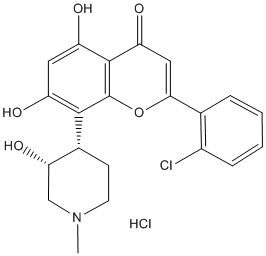All AbMole products are for research use only, cannot be used for human consumption.

Flavopiridol hydrochloride is a potent cyclin-dependent kinases inhibitor with an IC50 of 100 nM. Flavopiridol is the first cyclin-dependent kinase inhibitor. At the nanomolar concentrations, flavoporidol hydrochloride prevented rhabdoid cell growth with an IC50 ranging from 50 to 200 nM. Meanwhile, flavopiridol hydrochloride induced G1 and G2 arrest and apoptosis in vitro in a concentration-dependent manner. These influences were associated with the down- regulation of cyclin D1, up- modulation of p21, and induction of caspase 3/7 activities. At a dose of 7.5 mg/kg, flavopiridol markedly suppress the growth of xenografted rhabdoid tumors. That was associated with the induction of p21 and downregulation of cyclin D1. Treatment of flavopiridol decreased the activities of CDK2 and potently prevented cell proliferation with an IC50 ranging from 43 to 83 nM in HNSCC cells.
| Cell Experiment | |
|---|---|
| Cell lines | SUDHL4, SUDHL6, Jurkat, MOLT4, and HL60 |
| Preparation method | Growing cells at a density of 1 × 106 cells/mL are exposed to Flavopiridol for different concentrations and time periods. DNA is extracted. Briefly, washing cells once with cold phosphate-buffered saline (PBS) and lysing with 3 mL lysis buffer (5 mM Tris-HCL [pH 7.5]; 20 mM EDTA; 0.5% Triton X-100) for 15 minutes at 4 °C. The chromatin of the cell lysates is isolated by centrifugation (20 minutes at 26,000g, 4 °C). The supernatants containing small DNA fragments are extracted sequentially with phenol, phenol:chloroform (1:1), and chloroform. Nucleic acids are precipitated in 0.5 M NaCl, 90% ethanol at -20 °C overnight. Then digested RNA by bovine RNAaseA (60 μg/mL). After sequential reextraction and reprecipitation, DNA is dissolved in 10 mM Tris-HCL (pH 7.5), 1 mM EDTA, 0.5% sodium dodecyl sulfate (SDS) before electrophoresis on 1.6% agarose gel. |
| Concentrations | 0, 100 500, 5000 nM |
| Incubation time | 14 hours |
| Animal Experiment | |
|---|---|
| Animal models | Human prostate cancer xenografts, PRXFI337 and PRXFI369, grown s.c. in nude mice [4] Human promyelocytic leukemia HL-60, human B-cell follicular lymphoma SUDHL-4, and acquired immunodeficiency syndrome (AIDS)-r |
| Formulation | Water [4]; 1% DMSO [6] |
| Dosages | 10 mg/kg/d [4]; 7.5 mg/kg/d [6] |
| Administration | p.o.[4]; i.p. or i.v. [6] |
| Molecular Weight | 438.3 |
| Formula | C21H20ClNO5.HCl |
| CAS Number | 131740-09-5 |
| Solubility (25°C) | Water 20 mg/mL DMSO 22 mg/mL |
| Storage |
Powder -20°C 3 years ; 4°C 2 years In solvent -80°C 6 months ; -20°C 1 month |
[1] Michael Hallek. State-of-the-art treatment of chronic lymphocytic leukemia
| Related CDK Products |
|---|
| (E/Z)-Zotiraciclib citrate
(E/Z)-Zotiraciclib citrate is a potent CDK2, JAK2, and FLT3 inhibitor. |
| Abemaciclib metabolites M2
Abemaciclib metabolite M2 (LSN2839567) is a metabolite of Abemaciclib, acts as a potent CDK4 and CDK6 inhibitor, with IC50 values of 1.2 and 1.3 nM, respectively. |
| CDK9-IN-1
CDK9-IN-1 is a novel, selective CDK9 inhibitor, with an IC50 of 39 nM for CDK9/CycT1, it can be used for the research of HIV infection. |
| XO44
XO44 (PF-6808472) is a broad-spectrum covalent kinase probe. |
| ML 315
ML 315 is a selective dual inhibitor of CDK and DYRK with IC50s of 68 nM and 282 nM, respectively. |
All AbMole products are for research use only, cannot be used for human consumption or veterinary use. We do not provide products or services to individuals. Please comply with the intended use and do not use AbMole products for any other purpose.


Products are for research use only. Not for human use. We do not sell to patients.
© Copyright 2010-2024 AbMole BioScience. All Rights Reserved.
